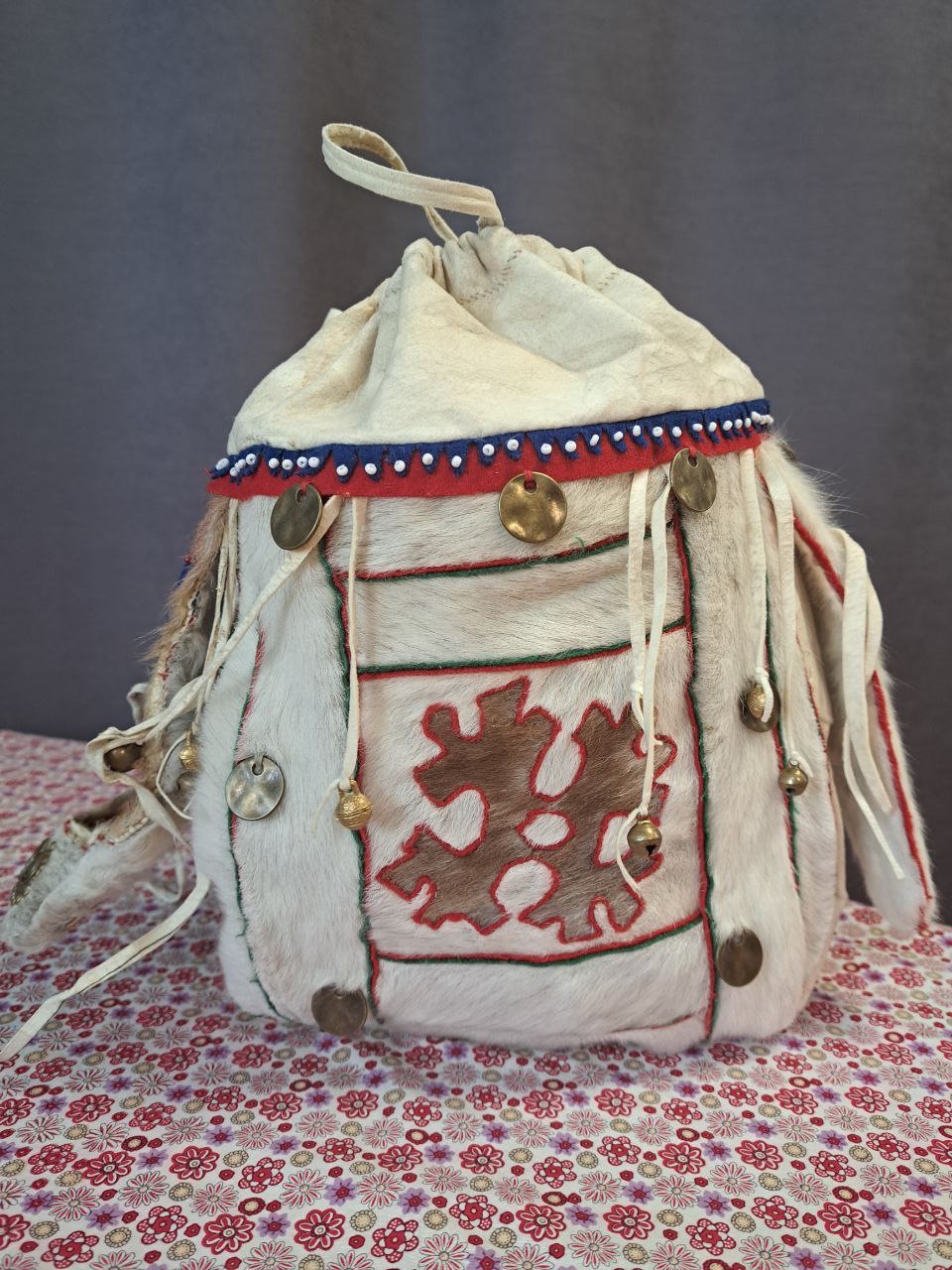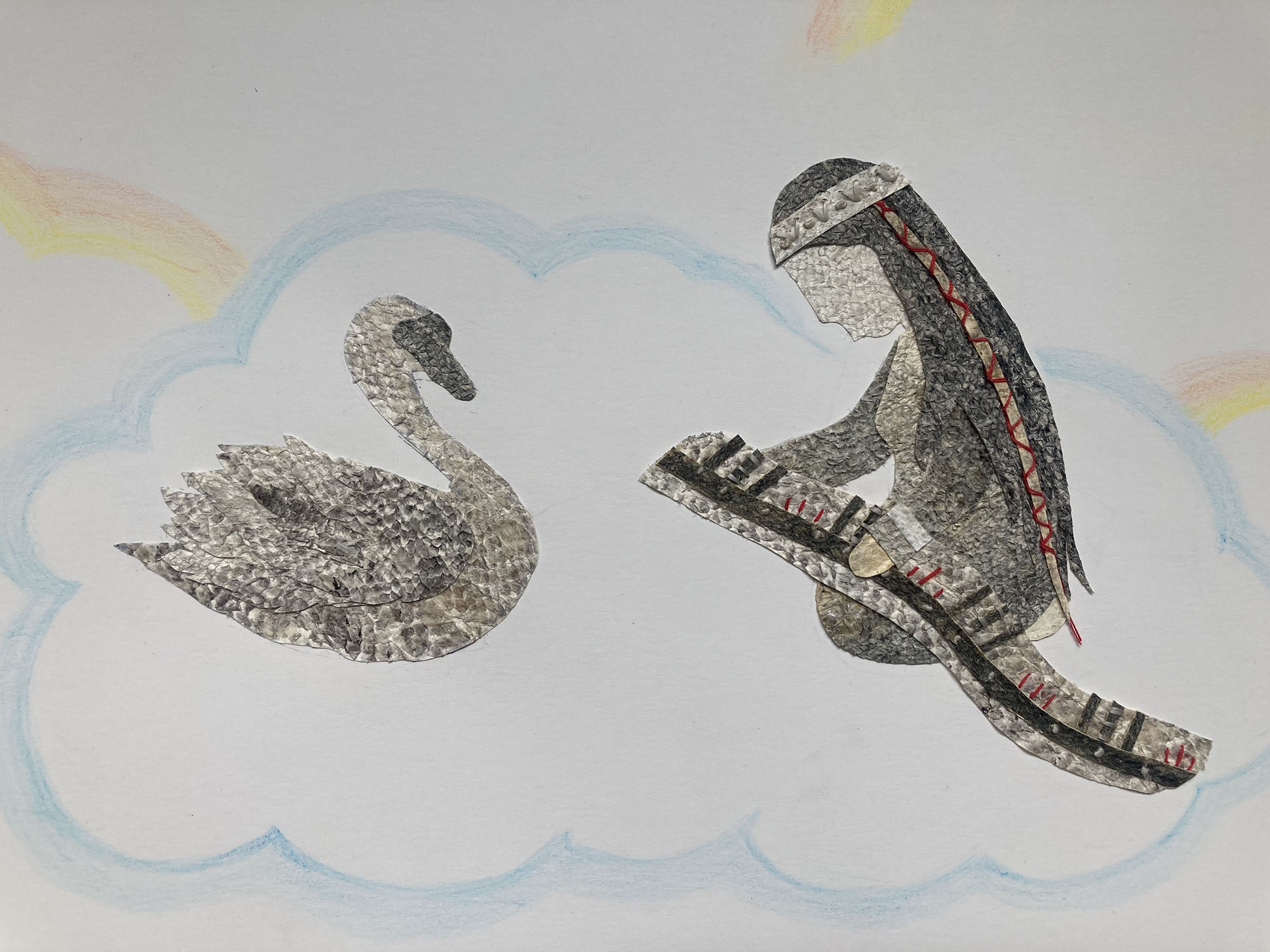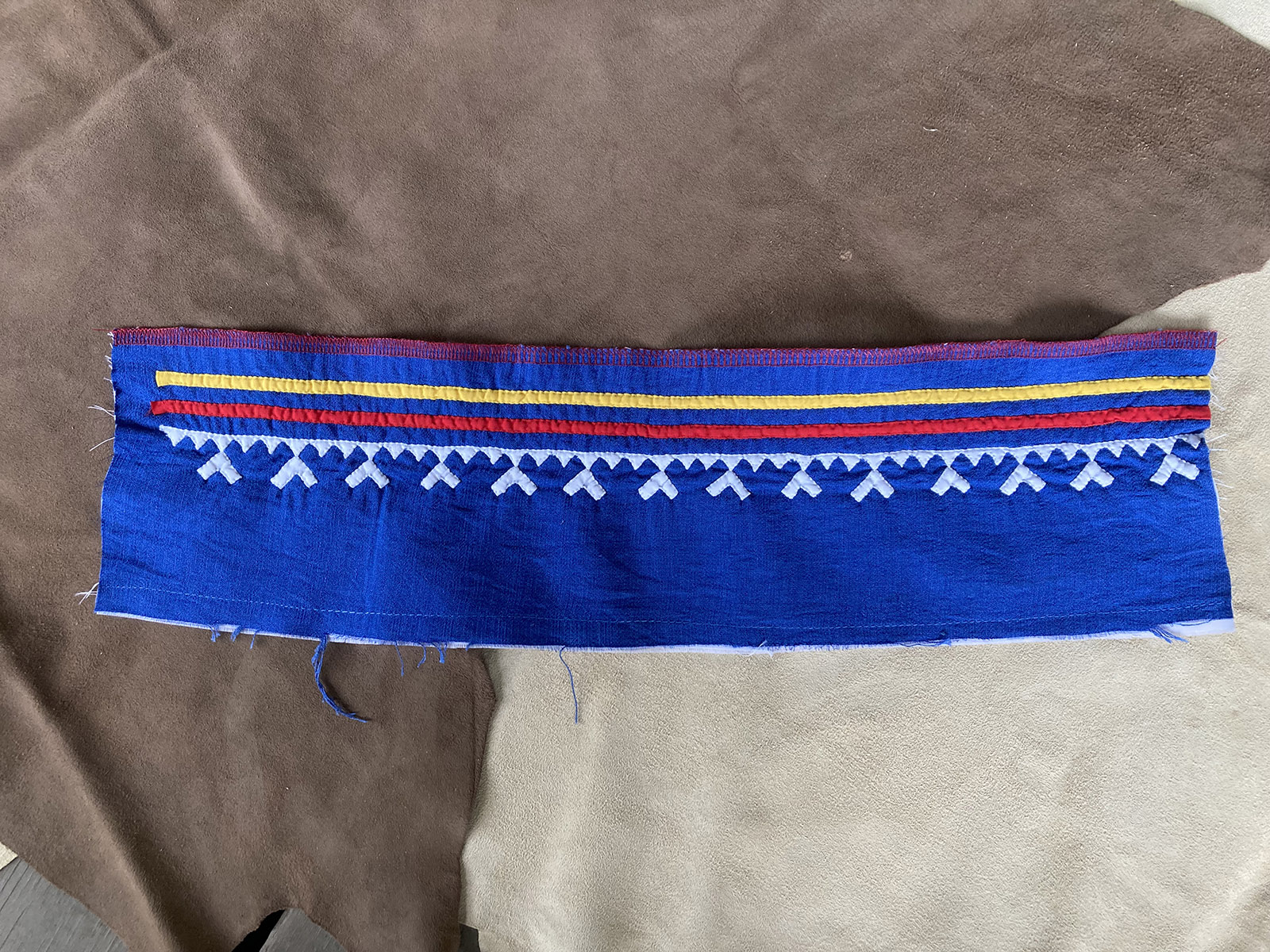Unfrozen Stories
Indigenous Art Forms as Living Reflections on Frozen Commons
Ice, snow, and permafrost are integral to Arctic human-nature connections. It provides shelter, water, and infrastructure, and forms Arctic identities. Indigenous Peoples’ livelihoods deeply intertwine with frozen landscapes. Our ancestors have developed diverse ways of interacting with, keeping and sharing knowledge about living in the cold environments, including through language, art, and ways of being. Deterioration of Arctic frozen environments driven by climate change impacts not only Indigenous communities but has the potential of affecting the whole of humanity. Complexity of problems the Arctic is facing today requires a search for new ways of discussing, understanding, and envisioning our relationship with land and water for now and for the future.
Unique long-standing relationships with frozen commons are masterfully incorporated into Indigenous art forms which can be understood as forms of art that stem from the holistic understanding of human and other then human relationships. With the goal of bringing Indigenous voices forward to speak about socio-environmental challenges, community well-being, justice and equality, success and failure, Indigenous art forms provide a glimpse into the knowledge base and experiences of Arctic communities building a bridge of understanding across diverse knowledge systems.
Intergenerational knowledge transfer and relationality are foundational for Indigenous creative storytelling and constitute the core basis in the creation of the art pieces. Knowledge of grass weaving, skin and fur sewing, beading, and carving does not come in one day. These skills come from within the community across multiple generations of meticulous practitioners and those observing them with care and are further delivered by artists and storytellers to wider audiences.
Stories skillfully crafted by Indigenous women seamlessly come together to celebrate the vibrant Arctic life and at the same time grieve the lost generations of knowledge holders, interrupted relations, and the rapidly melting ecosystem. Through this exhibition we draw attention to how Indigenous creative storytelling depicts delicate understanding of plentiful states of Arctic waters including diverse qualities of snow, variable conditions of ice, and rapidly changing permafrost grounds. Stories shared here represent strong and resilient cultures that continue relying on old and time-tested Indigenous smart technologies of comfortable living in the North. These stories were diligently gathered by generations of Indigenous hunters, reindeer herders, fishermen, berry and herb pickers, mothers, fathers, grandparents, great-grandparents… Depicting the essence of what it means to be a respectful and responsible citizen of the Arctic ecosystem, these artworks celebrate the beautiful Arctic lands and waters that are viewed by Indigenous Peoples not as wilderness and a hostile environment, but as a deeply loved home.
Text by Tatiana Degai
Content
- Reindeer Sinew
- Akanaj Dolls
- Embroidery with Khanty ornament
Haliehana Alaĝum Ayagaa Stepetin

The blended mediums of qiiĝam aĝadaa from the land and the sea reflect an Unangax̂ relationality to place that informs our survival and thriving in Unangam Tanangin, the Aleutian Islands of Alaska. Unangax̂ Peoples in and of Unangam Tanangin are at the maritime gateway to the Arctic via the Bering Sea and the Pacific Ocean.
Haliehana Alaĝum Ayagaa Stepetin. Qiiĝam aĝadaa / Grass sun medallion necklace. Hand-woven raffia with a basketry center; includes glass beads and is edged with chngatux̂ [sea otter] fur.
12.7×12.7 x 51 cm, 2024

Haliehana Alaĝum Ayagaa Stepetin. Isx̂atim Qitxuu ama Chngatum Qasii / Grass Basket Bottoms and Sea Otter Stitches.
28 x 28 cm, 2024
Amber Webb

Ink on Wood Panel.
68.6×30.5 cm, 2024


Amber Webb. Naqugun / Women’s Belt. Glass beads, pellon, nylon thread, white fox, ermine, moose hide. 152,4 x 20,32 cm, 2024.
Tatiana Degai
Xanč’an atxatxank ŋizzalank itǝnmǝn’i’n fčifče’n sunjɬqzuze’n. Inxse’nk nwe’n kannen’an atxatxanke, ma’ kč’amzanla’n sunjɬqzuze’n, nasqzuzwen ǝzzan ǝnfkatanoke inkneɬ ɬinmiwatamoke, lem č’amzanjɬꭓ’an wetwet ǝɬčkustnoke. Lem xan’an atxatxank č’inǝŋlaꭓ Zavina-Kugagt sunjɬqzuknen, min txsanom ek čqɬnom skǝzne’n. Ənnan klelx Balagitg sin. Nu ŋejŋex’al inxse’nk sǝmtanke nasqzuzen ǝnnan iwlaꭓa’njɬ k’imi’njɬ spǝl č’eliwatanoke.
S. P. Krasheninnikov kk’enjɬqzu’in: “It’e ma’ta inxt spleɬ inmisinazen, ǝnnan ktxǝŋ xank inxtenk ǝnzuznen ǝnxejwelaɬ nwonk q’ewq ek iwlq mank enmesenkas ǝnnanke ti’n lu’miznen. It’e 0qǝ’nizen qnaŋ spǝl pinjɬfa’sen, č’inaŋq ǝzzan leqzuzen.” (1949, p. 204)
Inki Balagitg mslelnǝŋx’al ɬaleqzuzen, Zavina kistenk kzuqzuznen. Ənna txɬknen či’nŋitiqzuznen, qǝmŋiqzuzen, p’ǝlꭓe’n anzazozne’n, k’imi’n ǝmtxlaznen. It’e Balagitg kestanke ilwiziqzuzen pǝɬčilki. Zavina eskčaq riwatqzuzen ti’nwekit qisꭓčaq č’ač’aqzuzen txsanok inkneɬ čqɬnok. Wen jaq Balagitg qa’m pǝɬč’ilkinkin inkneɬ manke ta ɬxiqzuzen, Zavina uzuqzuzen jatki, qisꭓčaꭓank jaja’n k’oɬqzuze’n, knaŋ čfqzuzen.
Kzos
Awaiting Balakitga
Tatiana Degai in collaboration with Viktor Ryzhkov, Jonathan Bobaljik, and Oleg Zaporotsky.
Inspired by the profound Itelmen creation story of the love between Zavina-Kugagt, the goddess of sunrise and dawn, and Balakitga, the spirit of the wind, “Awaiting Balakitga” captures a pivotal moment in their timeless existence.
As Zavina-Kugagt anticipates the return of her beloved Balakitga, she gracefully fills her days with the artistry of creation, weaving intricate garments with the companionship of her faithful friend, Swan. This artwork encapsulates the essence of this intimate scene, portraying Zavina-Kugagt as she meticulously stitches together the fabric of her elaborate garment, each thread a testament to her enduring love for Balakitga. Amidst her labor of love, Zavina-Kugagt’s melodic voice resonates with ancient melodies, filling the air with enchanting songs that echo the soul of Kamchatka’s beauty. The sun, a silent witness to her devotion, gracefully descends, casting a kaleidoscope of čʼačʼalaχ hues across the sky, a testament to the celestial romance that unfolds beneath its watchful gaze.
Crafted in collaboration with Itelmen language experts, including Viktor Ryzhkov and Jonathan Bobaljik, this artwork serves as a tribute to the rich cultural heritage and enduring spirit of the Itelmen people. The installation includes a series of photographs by Oleg Zaporotsky, capturing the beauty of the trational Itelmen lands and waters. Through its intricate details and evocative imagery, “Awaiting Balakitga” invites viewers to immerse themselves in the timeless story of love, longing, and the enduring power of creation.
Zavina-Kugagt’s Headdress is a homage to the frosty winters of Kamchatka, a land teeming with diverse life and boundless beauty. This piece seamlessly weaves together elements that capture the essence of the season. Inspired by the kaleidoscope of colors and textures found in Kamchatka’s snow-covered landscapes, the beadwork is an interpretation of nature’s intricate tapestry.
Tatiana Degai. Zavina-Kugagt’s Headdress. Off-loom bead weaving, string beading. Glass beads, pearls, sea shells, hare fur. 59 x47 cm, 2024
Elena Rybina

Four Generations of Ivoshyokh’s Bags
Author: Elena Rybina in collaboration with her family

Urkhir Bag
1-st Generation
The Urkhir bag for storing things was sewn over 80 years ago by my grandmother Tatyana Egorovna Rebas (Longortova), born in 1913. She was born in a traditional fishing settlement, and belonged to the large Longortov family, who lived in the upper reaches of the Sanya River. There were five sisters in the family. Their mother was a skilled seamstress and tried to pass on her skills to her daughters.

Yontastykhir Bag
2-nd Generation
"Yontastykhir" is a bag for storing necessary sewing and crafting tools. I made this bag in 2023 based on the pattern of an antique bag. Reindeer hide, dyed fabric, beads, and metal decorations were used for sewing this bag. For the decoration, I used the traditional Khanty “Sun” ornament.The bag is sewn with threads made from reindeer tendons and has all the attributes of a sewing bag with compartments for needles and thimble, as well as a case for scissors. I added red and green colors for a more interesting and bright ornament for this bag in particular.

Aikhur Bags
3-rd Generation Such bags are used for storing their dolls, ivory toys and pieces of sewing cloth. Presented here are two bags. One was created by my mother Natalia Aleksandrovna Gorshkova in 2021. The second handbag was sewn as a sewing learning exercise by my daughter Varvara under the delicate guidance of my mother. The ornament in the middle is called pine nut, the ornament along the bottom symbolizes reindeer antlers.
Reindeer sinew. 45×20 cm, 2024
Varvara and Aleksandra Rybina. Akanj dolls. Twisted cloths,13.5×8 (yellow headscarf) and 12.5×6.5 (red multicolour headscarf) cm, 2021
This artwork is a small depiction of the Khanty ornament called hare’s ears. It is made in the traditional applique on fabric technique. The fabric used on this example is cotton. Such technique and design would be used to decorate a Khanty dress.
Elena Rybina. Embroidery with Khanty ornament. 42×11 cm, 2023













